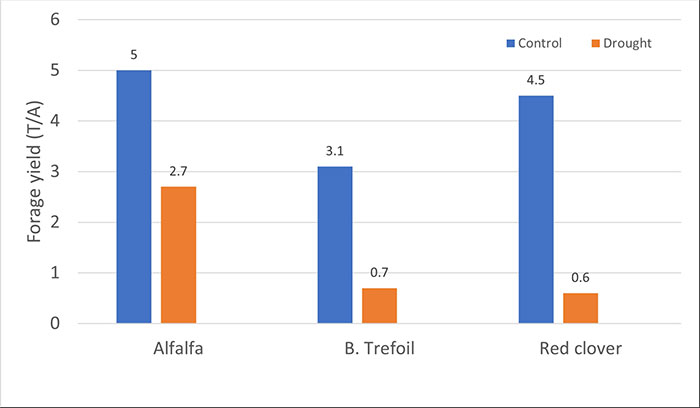
The summer slump has likely struck in pastures or hayfields with cool-season forage species. These plants inevitably experience a slowdown in growth this time of year because of the way they perform photosynthesis, but even though lower yields can be expected, not every cool-season species responds to drought stress to the same extent.
Craig Shaeffer with the University of Minnesota Extension notes cool-season species like alfalfa, red clover, orchardgrass, Kentucky bluegrass, and tall fescue are the backbone of forage systems in his state. The forage agronomist explains that plant growth tends to taper off when temperatures exceed 80°F. Warmer weather also heightens crop water use. Therefore, drought conditions can make the summer slump worse.
Despite these disadvantages, alfalfa tends to be one of the most drought-tolerant species among its cool-season counterparts. To demonstrate this, Shaeffer and other researchers conducted a study to compare forage yields of cool-season legumes grown under drought-like conditions to forage yields of the same plants grown in a control group.
“Because of its extensive root system, alfalfa will yield better than other commonly grown legumes, such as red clover and birdsfoot trefoil,” Shaeffer states. “Alfalfa has greater yield potential than these legumes under normal rainfall conditions, and its yield was reduced only 46% by severe drought compared to 80% or more for other legumes.”

Having a taproot system allows alfalfa to reach water deep in the soil profile. Alfalfa also stores energy reserves in its crown, which allows for a faster regrowth and recovery from drought than grasses that store energy reserves in their shoots. Grasses also have fibrous root systems that sit relatively shallow in the soil profile, limiting their water uptake.
Grass data
With that said, drought tolerance varies among cool-season grasses as well. Shaeffer and his colleagues also examined the difference in forage yields of cool-season grasses grown in a water deficit for three years with stands being harvested four times per year.

Orchardgrass showed the lowest reduction in yield at 53%, and Shaeffer notes this species maintains relatively good persistence and yield under drought stress. He suggests tall fescue and meadow fescue have similar characteristics to orchardgrass, although these species were not included in the study.
Smooth bromegrass and timothy showed average yield reductions of about 56%. Shaeffer explains the former species can withstand hot and dry weather, but it is more adapted to forage systems with two harvests per season. Timothy, on the other hand, has poor heat and drought tolerance. Shaeffer notes this species is better suited to northern regions of his state.
Reed canarygrass yields dropped 61%; however, forage yields were still greater than that of the other species in the study. Shaeffer pointed out reed canarygrass typically has high drought tolerance, but it can be difficult to establish, and current seed supplies may be low.
Since some cool-season species endure drought better than others, seeding a mixed stand of alfalfa and grass can be advantageous. “Having an alfalfa and cool-season grass mixture during drought provides a diversity of water-use efficiencies. If growth of shallower cool-season grasses shuts down, deep rooted alfalfa can provide some forage,” Shaeffer concludes.

